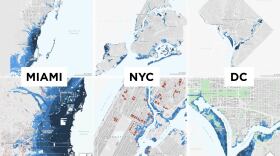-
This year's hurricane season got off to a very slow start. But it only takes one big storm to wreak havoc. And climate change makes such storms more likely.
-
The model created by the National Oceanic and Atmospheric Administration found that 70% of Florida's 350-mile long reef tract is eroding faster than it's growing.
-
Sens. Marco Rubio and Rick Scott are opposing a NOAA proposal that would reduce speed limits off the Southeast coast to protect the vanishing whales.
-
Researchers have begun holding workshops after a statewide survey found widespread misunderstanding of the forecast cone that's been used for 20 years.
-
Dalton Hesley led a dive team to an offshore Miami Beach reef last month in pursuit of sea urchins. Something else drew his attention instead. A cluster of staghorn corals, their branches reaching toward the surface, appeared a ghastly white.
-
One said meteorologist with the National Weather Service would be "failing in our jobs if we did not use this event as an opportunity to learn and also to capture how significant and how deadly the impacts have been in this area.”
-
It’s a question that follows any natural disaster, especially monster hurricanes like Ian: Was this caused by climate change?
-
Hurricane Ian came ashore with devastating near-Category 5 winds that peeled the roofs off homes and uprooted trees.
-
Over the last few decades, corals on the reef have been hammered by warmer water and ocean heat waves, disease and hurricanes. If the U.S. loses its reef tract, it loses a powerful defense against more intense hurricanes fueled by climate change.
-
NOAA projects that the high tide flood frequency between May 2022 and April 2023 will average 3-7 days, the same as the previous year, but an increase from the 2-6 days expected between 2019 and 2020.
-
The area of low to no oxygen— also known as a hypoxic zone— that can kill fish and marine life, is about 3,275 square miles.
-
National Hurricane Center data for Miami, Washington, D.C., and New York City show development happening in at-risk areas, even as climate change brings more frequent and intense storms.
Play Live Radio
Next Up:
0:00
0:00
Available On Air Stations










